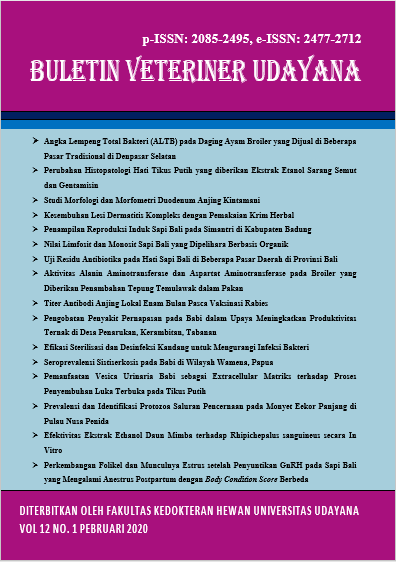Pemanfaatan Vesica Urinaria Babi sebagai Extracellular Matrix terhadap Proses Penyembuhan Luka Terbuka pada Tikus Putih
Abstrak
Extracellular matrix (ECM) saat ini adalah salah satu yang paling umum digunakan sebagai perancah untuk prosedur rekayasa jaringan. Extracellular matrix (ECM) bisa berasal dari submukosa usus kecil atau vesica urinaria (kandung kemih) babi. Tujuan penelitian ini adalah untuk mengetahui tingkat kecocokan dan keamanan penggunaan vesica urinaria babi sebagai Extracellular matrix (ECM) terhadap proses kesembuhan luka terbuka pada tikus putih serta mengetahui perubahan yang terjadi pada daerah implan pasca pemberian bahan serbuk vesica urinaria yang diamati secara makroskopis. Tiga puluh dua ekor tikus putih jantan yang akan dipergunakan pada penelitian diadaptasi lingkungan selama 1 minggu dan diberikan pakan komersial (merk pellet 552) dan air minum ad libitum. Tikus dibagi menjadi dua kelompok masing-masing berjumlah 16 ekor. Kelompok I (perlakuan) yaitu 16 tikus pada daerah punggungnya dilukai dengan pisau scalpel sedalam 2 mm dan panjang 2 cm dan diberikan perlakuan bahan Extracellular matrix yang berasal dari vesica urinaria babi. Kelompok II (kontrol) yaitu 16 tikus diperlakukan sama dengan kelompok I dan tidak diberi perlakuan. Monitoring keamanan bahan matriks dilakukan pengamatan perkembangan kesembuhan luka pada 24 jam, hari ke 5, hari ke-10, dan hari ke-15 pasca operasi dengan pengamatan makros (kemerahan, bengkak, dan keropeng). Hasil pemeriksaan menunjukkan bahwa pemberian bahan Extracellular matrix mempercepat proses kesembuhan luka dibandingkan kelompok kontrol dengan tanda luka tertutup sempurna pada hari ke-15.
##plugins.generic.usageStats.downloads##
Referensi
Titiek B, Waskito EB, Suwarno. 2007. Biochemical characterization of an antibacterial glycoprotein from Achatina fulica ferussac snail mucus local isolate and their implication on bacterial dental infection. Indonesia J. Biotechnol. 12(1): 944.
Cockbill S. 2002. Wounds the healing process. The Welsh School of Pharmacy. University College. Cardif.
Dealey C. 1994. The Care of Wound. Blackwell Science. USA.
Freytes OD, Jeffrey M, Sachin SV, Annie SL, Badylak SF. 2008. Preparation and rheological characterization of a gel form of the porcine urinary bladder matrix. Biomaterials 29: 1630-1637.
Freshney RI. 1986. Animal Cell Culture. Glasgow (UK): IRL Press.
Parker F. 1991. Structure and Function of The Skin. In Dermatology. M. Orkin, H.I. Maibach, dan M.V. Dahl. A Lange Medical Book.USA
Pavleti M.M. 1992. Veterynary Emergency and Critical Care Medicine. Editor Robert J. Murtaugh and Paul M. Kaplan. Mosby Year Book. Toronto. New York
Peterson AS. 2010. The Golden period for wound repair. J. Lancaster General Hospital. 5(4): 134-135.
Pires IM, Garcia N, 2015. Wound area assessment using mobile application. Int. Conference on Biomedical Electronics and Devices. Pp. 271-282.
Prestyo BF, Wientarsih I, Priosoeryanto BP. 2010. Aktivitas sediaan gel ekstrak batang pohon pisang ambon dalam proses penyembuhan luka pada mencit. J. Vet. 11(2): 70-73.
Prodan A, Rusu M, Campean R, Prodan R. 2006. A java framework for analyzing and processing wound images for medical education. Proceedings 20th European Conference on Modelling and Simulation (ECMS).
Zhang Y, Kropp BP, Lin HK, Cowan R, Cheng EY. 2004. Bladder regeneration with cell-seeded small intestinal submucosa. Tissue Eng. 10: 181–187.
Zulfa, Murachman E, Gayatri D. 2008. Perbandingan Penyembuhan luka terbuka menggunakan balutan Madu atau balutan normal salin-povidone iodine. J Keperawatan Indo. 12(1): 34-39.





